Bohan Zhang
NetEase
Neural Networks Learn Generic Multi-Index Models Near Information-Theoretic Limit
Nov 19, 2025Abstract:In deep learning, a central issue is to understand how neural networks efficiently learn high-dimensional features. To this end, we explore the gradient descent learning of a general Gaussian Multi-index model $f(\boldsymbol{x})=g(\boldsymbol{U}\boldsymbol{x})$ with hidden subspace $\boldsymbol{U}\in \mathbb{R}^{r\times d}$, which is the canonical setup to study representation learning. We prove that under generic non-degenerate assumptions on the link function, a standard two-layer neural network trained via layer-wise gradient descent can agnostically learn the target with $o_d(1)$ test error using $\widetilde{\mathcal{O}}(d)$ samples and $\widetilde{\mathcal{O}}(d^2)$ time. The sample and time complexity both align with the information-theoretic limit up to leading order and are therefore optimal. During the first stage of gradient descent learning, the proof proceeds via showing that the inner weights can perform a power-iteration process. This process implicitly mimics a spectral start for the whole span of the hidden subspace and eventually eliminates finite-sample noise and recovers this span. It surprisingly indicates that optimal results can only be achieved if the first layer is trained for more than $\mathcal{O}(1)$ steps. This work demonstrates the ability of neural networks to effectively learn hierarchical functions with respect to both sample and time efficiency.
ArchMap: Arch-Flattening and Knowledge-Guided Vision Language Model for Tooth Counting and Structured Dental Understanding
Nov 18, 2025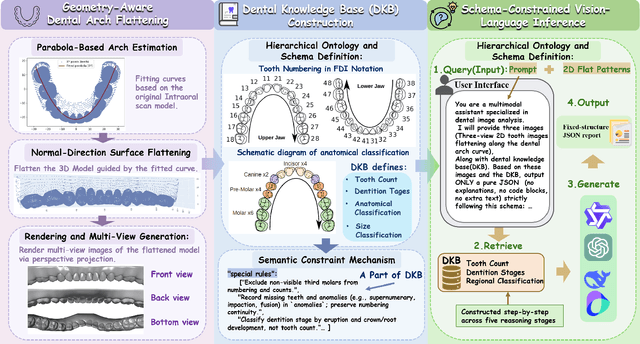
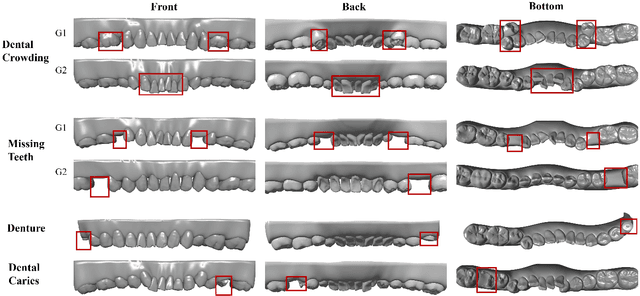
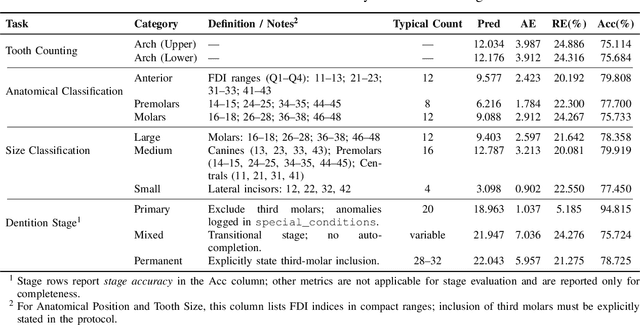
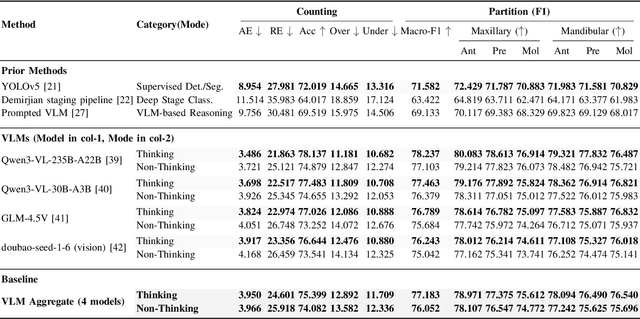
Abstract:A structured understanding of intraoral 3D scans is essential for digital orthodontics. However, existing deep-learning approaches rely heavily on modality-specific training, large annotated datasets, and controlled scanning conditions, which limit generalization across devices and hinder deployment in real clinical workflows. Moreover, raw intraoral meshes exhibit substantial variation in arch pose, incomplete geometry caused by occlusion or tooth contact, and a lack of texture cues, making unified semantic interpretation highly challenging. To address these limitations, we propose ArchMap, a training-free and knowledge-guided framework for robust structured dental understanding. ArchMap first introduces a geometry-aware arch-flattening module that standardizes raw 3D meshes into spatially aligned, continuity-preserving multi-view projections. We then construct a Dental Knowledge Base (DKB) encoding hierarchical tooth ontology, dentition-stage policies, and clinical semantics to constrain the symbolic reasoning space. We validate ArchMap on 1060 pre-/post-orthodontic cases, demonstrating robust performance in tooth counting, anatomical partitioning, dentition-stage classification, and the identification of clinical conditions such as crowding, missing teeth, prosthetics, and caries. Compared with supervised pipelines and prompted VLM baselines, ArchMap achieves higher accuracy, reduced semantic drift, and superior stability under sparse or artifact-prone conditions. As a fully training-free system, ArchMap demonstrates that combining geometric normalization with ontology-guided multimodal reasoning offers a practical and scalable solution for the structured analysis of 3D intraoral scans in modern digital orthodontics.
GLM-4.5: Agentic, Reasoning, and Coding (ARC) Foundation Models
Aug 08, 2025Abstract:We present GLM-4.5, an open-source Mixture-of-Experts (MoE) large language model with 355B total parameters and 32B activated parameters, featuring a hybrid reasoning method that supports both thinking and direct response modes. Through multi-stage training on 23T tokens and comprehensive post-training with expert model iteration and reinforcement learning, GLM-4.5 achieves strong performance across agentic, reasoning, and coding (ARC) tasks, scoring 70.1% on TAU-Bench, 91.0% on AIME 24, and 64.2% on SWE-bench Verified. With much fewer parameters than several competitors, GLM-4.5 ranks 3rd overall among all evaluated models and 2nd on agentic benchmarks. We release both GLM-4.5 (355B parameters) and a compact version, GLM-4.5-Air (106B parameters), to advance research in reasoning and agentic AI systems. Code, models, and more information are available at https://github.com/zai-org/GLM-4.5.
ExAnte: A Benchmark for Ex-Ante Inference in Large Language Models
May 26, 2025Abstract:Large language models (LLMs) face significant challenges in ex-ante reasoning, where analysis, inference, or predictions must be made without access to information from future events. Even with explicit prompts enforcing temporal cutoffs, LLMs often generate outputs influenced by internalized knowledge of events beyond the specified cutoff. This paper introduces a novel task and benchmark designed to evaluate the ability of LLMs to reason while adhering to such temporal constraints. The benchmark includes a variety of tasks: stock prediction, Wikipedia event prediction, scientific publication prediction, and Question Answering (QA), designed to assess factual knowledge under temporal cutoff constraints. We use leakage rate to quantify models' reliance on future information beyond cutoff timestamps. Experimental results reveal that LLMs struggle to consistently adhere to temporal cutoffs across common prompting strategies and tasks, demonstrating persistent challenges in ex-ante reasoning. This benchmark provides a potential evaluation framework to advance the development of LLMs' temporal reasoning ability for time-sensitive applications.
NurValues: Real-World Nursing Values Evaluation for Large Language Models in Clinical Context
May 13, 2025Abstract:This work introduces the first benchmark for nursing value alignment, consisting of five core value dimensions distilled from international nursing codes: Altruism, Human Dignity, Integrity, Justice, and Professionalism. The benchmark comprises 1,100 real-world nursing behavior instances collected through a five-month longitudinal field study across three hospitals of varying tiers. These instances are annotated by five clinical nurses and then augmented with LLM-generated counterfactuals with reversed ethic polarity. Each original case is paired with a value-aligned and a value-violating version, resulting in 2,200 labeled instances that constitute the Easy-Level dataset. To increase adversarial complexity, each instance is further transformed into a dialogue-based format that embeds contextual cues and subtle misleading signals, yielding a Hard-Level dataset. We evaluate 23 state-of-the-art (SoTA) LLMs on their alignment with nursing values. Our findings reveal three key insights: (1) DeepSeek-V3 achieves the highest performance on the Easy-Level dataset (94.55), where Claude 3.5 Sonnet outperforms other models on the Hard-Level dataset (89.43), significantly surpassing the medical LLMs; (2) Justice is consistently the most difficult nursing value dimension to evaluate; and (3) in-context learning significantly improves alignment. This work aims to provide a foundation for value-sensitive LLMs development in clinical settings. The dataset and the code are available at https://huggingface.co/datasets/Ben012345/NurValues.
PHYBench: Holistic Evaluation of Physical Perception and Reasoning in Large Language Models
Apr 22, 2025



Abstract:We introduce PHYBench, a novel, high-quality benchmark designed for evaluating reasoning capabilities of large language models (LLMs) in physical contexts. PHYBench consists of 500 meticulously curated physics problems based on real-world physical scenarios, designed to assess the ability of models to understand and reason about realistic physical processes. Covering mechanics, electromagnetism, thermodynamics, optics, modern physics, and advanced physics, the benchmark spans difficulty levels from high school exercises to undergraduate problems and Physics Olympiad challenges. Additionally, we propose the Expression Edit Distance (EED) Score, a novel evaluation metric based on the edit distance between mathematical expressions, which effectively captures differences in model reasoning processes and results beyond traditional binary scoring methods. We evaluate various LLMs on PHYBench and compare their performance with human experts. Our results reveal that even state-of-the-art reasoning models significantly lag behind human experts, highlighting their limitations and the need for improvement in complex physical reasoning scenarios. Our benchmark results and dataset are publicly available at https://phybench-official.github.io/phybench-demo/.
FairACE: Achieving Degree Fairness in Graph Neural Networks via Contrastive and Adversarial Group-Balanced Training
Apr 15, 2025Abstract:Fairness has been a significant challenge in graph neural networks (GNNs) since degree biases often result in un-equal prediction performance among nodes with varying degrees. Existing GNN models focus on prediction accuracy, frequently overlooking fairness across different degree groups. To addressthis issue, we propose a novel GNN framework, namely Fairness- Aware Asymmetric Contrastive Ensemble (FairACE), which inte-grates asymmetric contrastive learning with adversarial training to improve degree fairness. FairACE captures one-hop local neighborhood information and two-hop monophily similarity to create fairer node representations and employs a degree fairness regulator to balance performance between high-degree and low-degree nodes. During model training, a novel group-balanced fairness loss is proposed to minimize classification disparities across degree groups. In addition, we also propose a novel fairness metric, the Accuracy Distribution Gap (ADG), which can quantitatively assess and ensure equitable performance across different degree-based node groups. Experimental results on both synthetic and real-world datasets demonstrate that FairACE significantly improves degree fairness metrics while maintaining competitive accuracy in comparison to the state-of-the-art GNN models.
Policy Learning with a Natural Language Action Space: A Causal Approach
Feb 24, 2025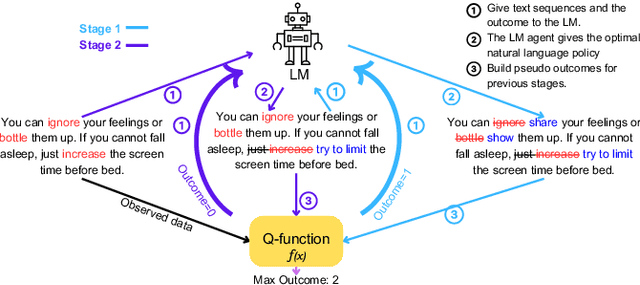


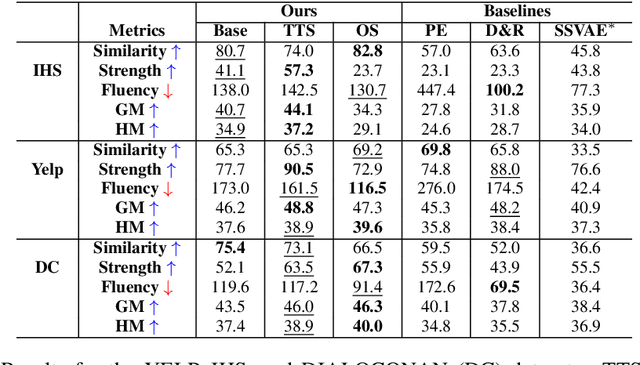
Abstract:This paper introduces a novel causal framework for multi-stage decision-making in natural language action spaces where outcomes are only observed after a sequence of actions. While recent approaches like Proximal Policy Optimization (PPO) can handle such delayed-reward settings in high-dimensional action spaces, they typically require multiple models (policy, value, and reward) and substantial training data. Our approach employs Q-learning to estimate Dynamic Treatment Regimes (DTR) through a single model, enabling data-efficient policy learning via gradient ascent on language embeddings. A key technical contribution of our approach is a decoding strategy that translates optimized embeddings back into coherent natural language. We evaluate our approach on mental health intervention, hate speech countering, and sentiment transfer tasks, demonstrating significant improvements over competitive baselines across multiple metrics. Notably, our method achieves superior transfer strength while maintaining content preservation and fluency, as validated through human evaluation. Our work provides a practical foundation for learning optimal policies in complex language tasks where training data is limited.
CoT-based Synthesizer: Enhancing LLM Performance through Answer Synthesis
Jan 03, 2025



Abstract:Current inference scaling methods, such as Self-consistency and Best-of-N, have proven effective in improving the accuracy of LLMs on complex reasoning tasks. However, these methods rely heavily on the quality of candidate responses and are unable to produce correct answers when all candidates are incorrect. In this paper, we propose a novel inference scaling strategy, CoT-based Synthesizer, which leverages CoT reasoning to synthesize superior answers by analyzing complementary information from multiple candidate responses, even when all candidate responses are flawed. To enable a lightweight and cost-effective implementation, we introduce an automated data generation pipeline that creates diverse training data. This allows smaller LLMs trained on this data to improve the inference accuracy of larger models, including API-based LLMs. Experimental results across four benchmark datasets with seven policy models demonstrate that our method significantly enhances performance, with gains of 11.8% for Llama3-8B and 10.3% for GPT-4o on the MATH dataset. The corresponding training data and code are publicly available on https://github.com/RUCKBReasoning/CoT-based-Synthesizer.
Metasurface-generated large and arbitrary analog convolution kernels for accelerated machine vision
Sep 27, 2024



Abstract:In the rapidly evolving field of artificial intelligence, convolutional neural networks are essential for tackling complex challenges such as machine vision and medical diagnosis. Recently, to address the challenges in processing speed and power consumption of conventional digital convolution operations, many optical components have been suggested to replace the digital convolution layer in the neural network, accelerating various machine vision tasks. Nonetheless, the analog nature of the optical convolution kernel has not been fully explored. Here, we develop a spatial frequency domain training method to create arbitrarily shaped analog convolution kernels using an optical metasurface as the convolution layer, with its receptive field largely surpassing digital convolution kernels. By employing spatial multiplexing, the multiple parallel convolution kernels with both positive and negative weights are generated under the incoherent illumination condition. We experimentally demonstrate a 98.59% classification accuracy on the MNIST dataset, with simulations showing 92.63% and 68.67% accuracy on the Fashion-MNIST and CIFAR-10 datasets with additional digital layers. This work underscores the unique advantage of analog optical convolution, offering a promising avenue to accelerate machine vision tasks, especially in edge devices.
 Add to Chrome
Add to Chrome Add to Firefox
Add to Firefox Add to Edge
Add to Edge